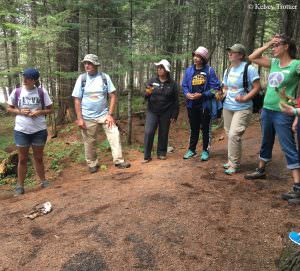It’s that time of year again, swapping in bathing suits for rain jackets and backpacks full of camping gear for school supplies. It’s back to school time!
Here at the Conservation Council of New Brunswick, our Learning Outside project focuses on helping New Brunswick children connect with nature. To do this, we help teachers integrate nature into the teaching of all subjects through the development of outdoor learning spaces and through teacher-training opportunities. Nadine, our Learning Outside project coordinator is a member of the Great Minds Think Outside team, a collaboration of educators from a range of organizations and government departments that provides outdoor training sessions for teachers and other educators. Last week, I got to attend one of these Great Minds Think Outside sessions with several other eager and like-minded individuals at the Mactaquac Provincial Park Beaver Pond.
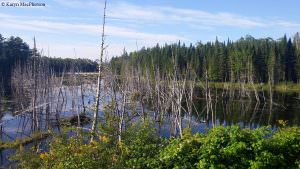
We arrived to the Beaver Pond area (I had never been before) to the sun shining, birds chirping and bees buzzing. I definitely recommend visiting this beautiful park with the kids on your own. Parks NB has set up many activities for kids encouraging them to explore nature in their own unique ways.
Once participants arrived, we began the day doing warm-up and high energy activities, all very useful when you arrive to an outdoor space with several excited students and/or children. My favourite high-energy activity was ‘Wetland Values’, taught to us by Emma, who works with Nature NB. What kid (of any age!) doesn’t love a relay?
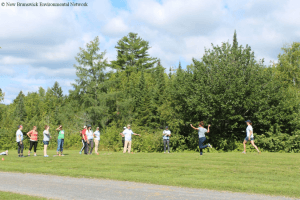
This relay consisted of working as a team to answer questions related to wetlands. “Wetlands help to filter water,” shouted the facilitator. Off I went to grab a strainer from the bucket at the end of the relay. To add another layer of fun onto this activity, each team came up with an animal that would visit or live in a wetland. We then had to “act” like this animal throughout the relay. “Wetlands provide food”. Cawing and flapping my wings, I was on the hunt to grab the food item from the bin. Not only does this activity make children think and learn the importance of wetlands, it also allows them to blow off a little steam—something with which every parent is familiar. This activity could be adapted to other New Brunswick habitats as well: Acadian forests, freshwater, marine, etc.
We continued the morning with team-building and problem-solving activities – the basics of being a good environmental steward who’s also able to have fun. After lunch, we had the opportunity to go critter dipping! Parks NB has all the supplies ready for anyone who enters the park and wants to see what critters they can find. Our group caught an array of critters: tadpoles, frogs, leeches, and minnows; our facilitator Ian even found a garter snake!
These up-close and personal interactions are perfect for kids who may be apprehensive about nature’s little creatures. It gives them a chance to appreciate the importance of the diverse species in their areas with enthusiasm and curiosity.
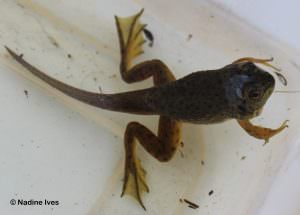
Next, we met at the entrance to the walking trail for my two favourite activities. We paired up with someone else and began to create a ‘sundae’ with the forest floor providing our ingredients. This is another fun and easy way for kids to connect with nature with something not many kids could turn down—sundaes!
For this activity we were given a cup to gather our materials to make the “sundae”. However, as you may have guessed, this is no edible sundae – this activity’s true title is ‘whiff sundae’ for a reason. In our teams of two, we had to come up with a creative name to call our sundae by sniffing it, or “taking a big whiff” as our coordinators explained to us. This activity is perfect to play after high-energy games; it takes more serious contemplation and thoughtful discovery. Being able to touch and smell, to have hands-on experiences in nature, is very important for kids and students from a young age.
My partner and I also arranged our items to be aesthetically pleasing – something everybody could get on board with. This activity could be incorporated into an art class or an art project at home, painting your “whiff sundae”! Names varied from “A Fresh Moment” (my team’s!) to “David’s Tea Forest Floor Blend”, smelling very much like it could be steeped into a beautiful tea!
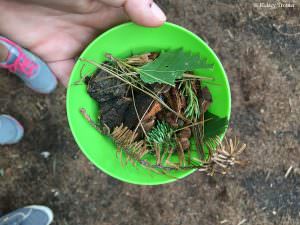
One of our final wrap-up, reflective activities was “Micro-Parks”. This is fosters independence, imagination and responsibility in participants and is paramount in helping children understand their role in the environment.
This activity can be done in groups or individually. We created our park in a team of four. We were given a small amount of string and 10 toothpicks with tiny flags attached. The string is used as a boundary and the flags as points of interest. We worked as a team to create a space for our park and then identify certain things we wanted highlight… Our park had a rockwall (a cluster of mushrooms growing from the side of a decomposing log), ski-mountain (large log, split in several places), a zipline (a spider’s web) and many other ‘tiny attractions’. This activity can be altered by creating a hike through your micro-park. Students can sketch it and then write about their hiking route of park attractions! Give it a try – see what happens as your kids become immersed in a magical forest world of their own.
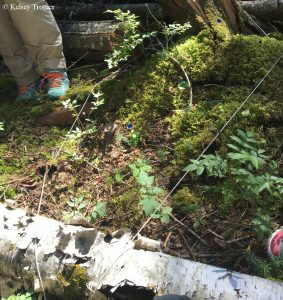
Of course all these activities can be adapted to any season, instead of whiff sundaes in the winter, you could gather scents from the trees and bushes instead of the forest floor, adapt a relay to winter survival tactics different animals have or change it into a food chain relay!
Remember the changing weather does not mean we have to change our attitude on being outside! Outdoor play has a positive impact on children’s development leaving children healthier, happier and more aware. So this back-to-school season, let’s get back to nature and continue the connection to the outdoors for our children and families.
For more information on activities you can play and learn with children, visit the Learning Outside website: http://www.learningoutside.ca/ or contact Nadine at nadine@conservationcouncil.ca. Share your ideas and great adventures with us on Facebook, Twitter and Instagram!
